Contents
Not everyone knows how to sterilize jars in the microwave. After all, stoves are bought primarily for the sake of quickly heating food. It turns out that they can be used to disinfect glass containers.
The classic sterilization process always gives housewives a lot of trouble: you have to boil water and steam each container. Without hot processing, it is strictly forbidden to use dishes for preservation. At best, it will explode, and the products will be thrown away. At worst, botulinum toxin will appear, a terrible poison that is deadly to humans.
In order for canned foods to be safe, it is necessary to strictly follow the rules of canning and especially sterilization.
How to properly prepare a container
No matter how clean the glass jar is, it must be thoroughly washed and sterilized. Detergent must be washed off several times. Glass container preparation process:
- Check the integrity of the glass: there should not be any cracks, chips, or other defects. If you ignore the damage, the glass will simply burst when heated.
- Rinse containers. It is advisable to use soda – it is harmless, easily washed off the glass surface.
- Sterilize washed jars.
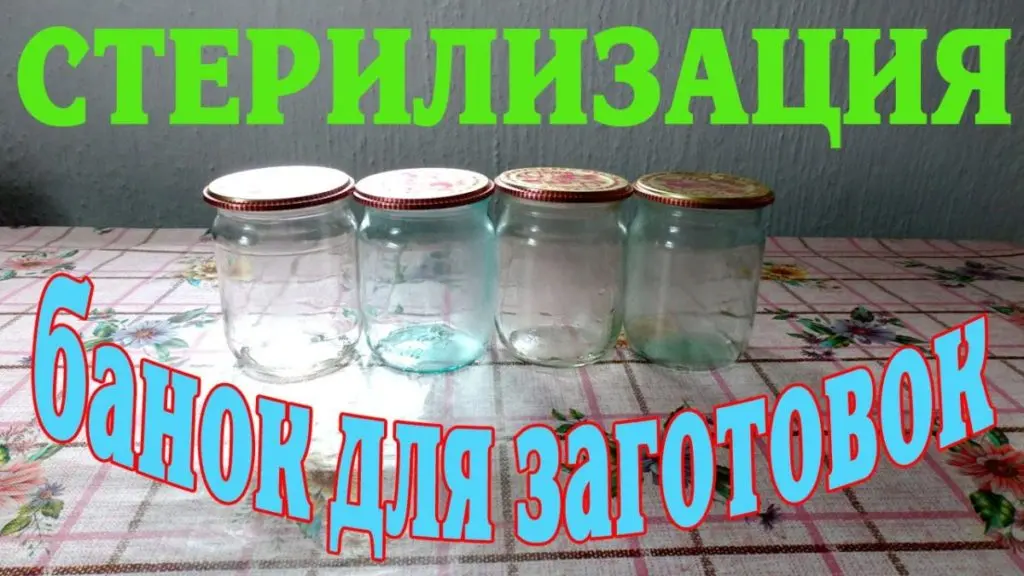
Advantages and disadvantages
Sterilization in a microwave oven is convenient because:
- You can process several half-liter cans at once.
- The process is not accompanied by an increase in humidity and temperature in the kitchen.
- Processing in a microwave oven takes less time and effort than classical methods.
Disadvantages:
- 3 liters – the maximum volume of sterilized containers.
- They have to be placed on their side.
- Electricity is consumed.
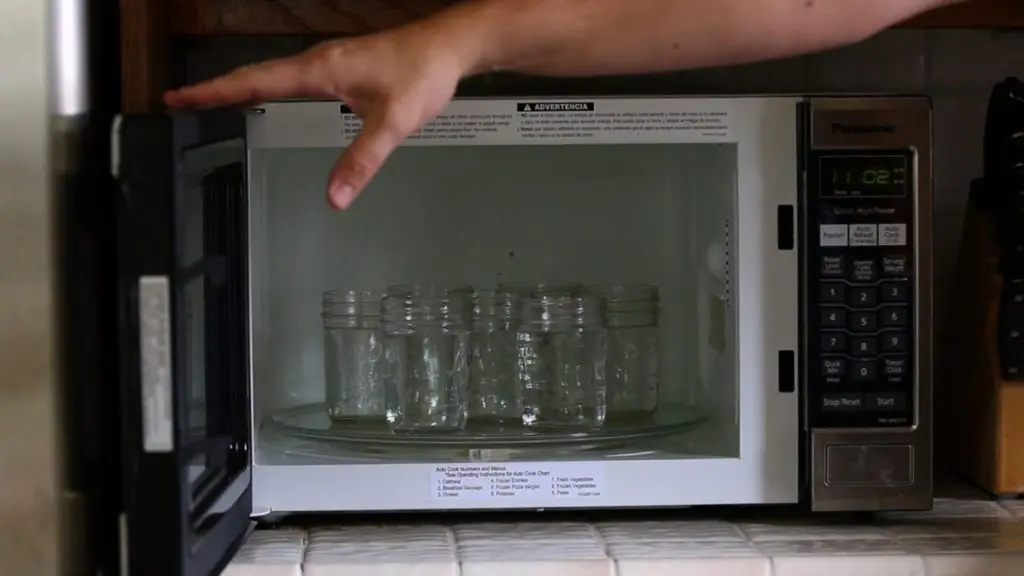
Processing options
Conventional sterilization is steaming over a saucepan or boiling in water. This not only takes a lot of time, but also builds up humidity in the room, raises the temperature. Yes, and fuss with boiling water is always dangerous. Many housewives doubt whether it is possible to sterilize glass containers in a microwave oven. Not only possible, but also very convenient. One prerequisite is that there must be lids.
There are several options for sterilization:
- with water;
- without water;
- with preparations.
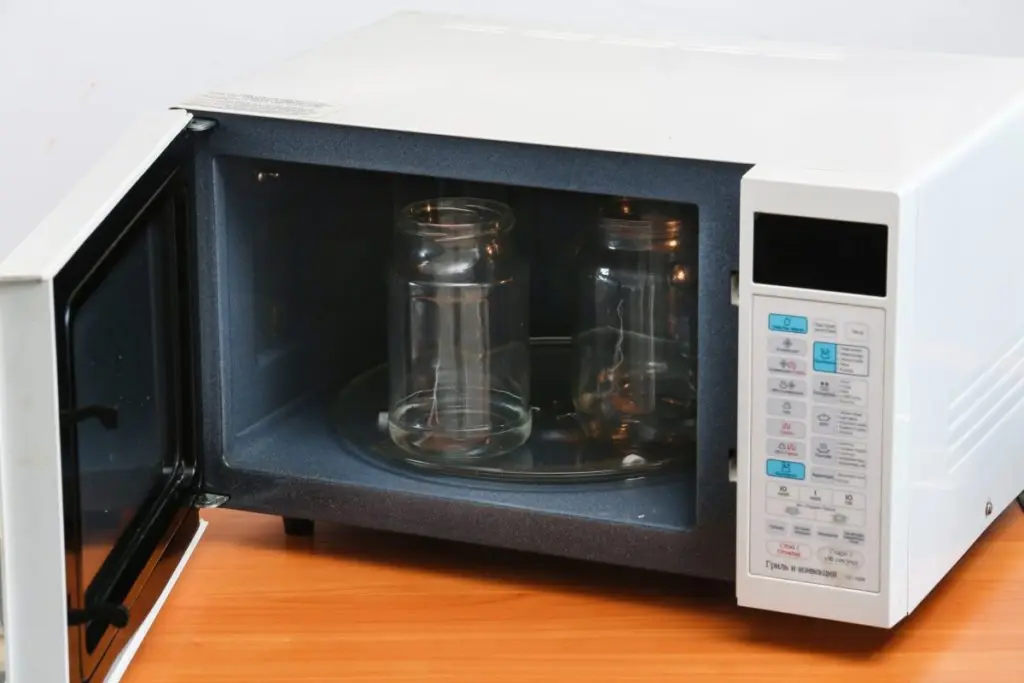
Steam sterilization
- A little water is poured into the washed jars – 2 cm is enough. It is advisable to use filtered water – it does not leave traces of lime when it boils.
- Put the jars in the microwave oven. Without lids.
- Turn on the microwave at 0,7-0,8 kW.
- Now we have to wait. How many minutes is enough to properly sanitize glassware? It takes 2-3 minutes. How long to sterilize depends on the volume: the larger it is, the longer the process. A three-liter one should be kept for 5-6 minutes. In general, it is recommended to focus on boiling: wait 1-3 minutes from the moment it starts. Then you can turn off the microwave. Water, boiling and releasing steam, kills all pathogenic microbes.
- Sterilized containers are hot, so they are taken out with a towel or potholders, which should not be wet – the glass is likely to crack due to temperature differences. It is forbidden to take them by the neck – it is dangerous. Take them out with both hands.
- Water that has not boiled over is discarded. Now you need to immediately, without delay, fill the finished container with products for canning. If several jars are being prepared, they should be placed upside down on a clean rag or towel. Turn them over just before filling with hot products that need to be pasteurized beforehand.
At the same time, no more than five jars (0,5-1 l) are placed in the microwave oven. Three-liters have to be put on their side. A little water is also poured into them – it does not flow out when placed horizontally. It is recommended to spread a cotton towel, you can also put it on a plate.
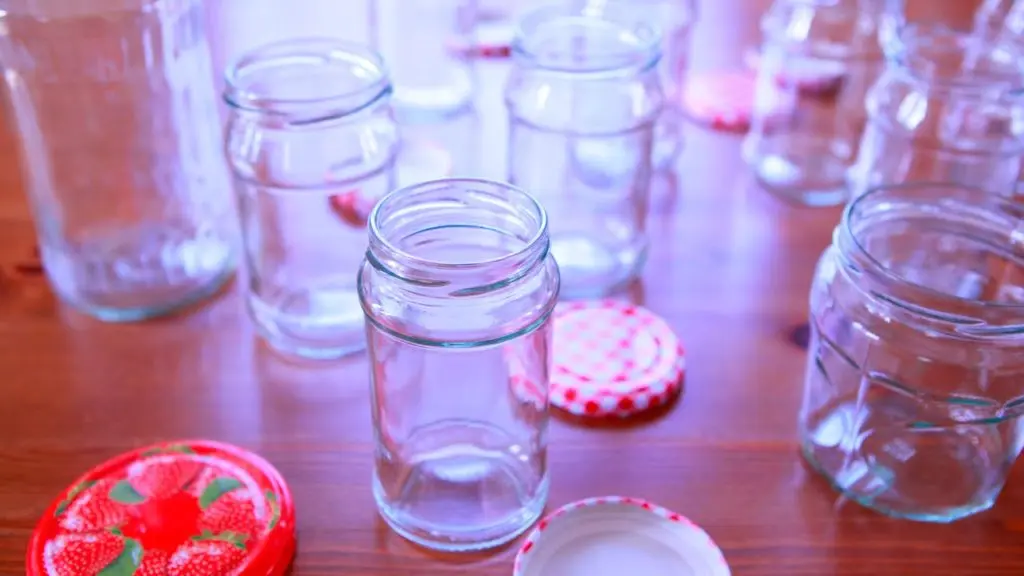
Sterilization without water
With the dry method, the liquid does not have direct contact with the glass – it can be called combined, since there is a simultaneous treatment with microwave rays and steam.
Dry disinfection technology:
- Inspect the containers for chips and cracks, set aside unsuitable ones.
- Rinse with soda and wipe with a sponge. After washing off the soda, place the dishes upside down on a clean towel. Start the procedure after complete drying.
- You will need a glass of 250-300 ml. Pour filtered water into it. It is not necessary to fill the glass to the brim, leave 3-4 cm, otherwise it, having boiled, will pour out onto the rotating tray.
- Place the glass in the middle of the chamber, place empty jars around it, and set the time: five minutes. Set the power to 0,75 kW.
- When the timer turns off the microwave, remove the hot dish with an oven mitt. Now you can fill it with jam or squash caviar, the main thing is to prevent a sharp temperature drop.
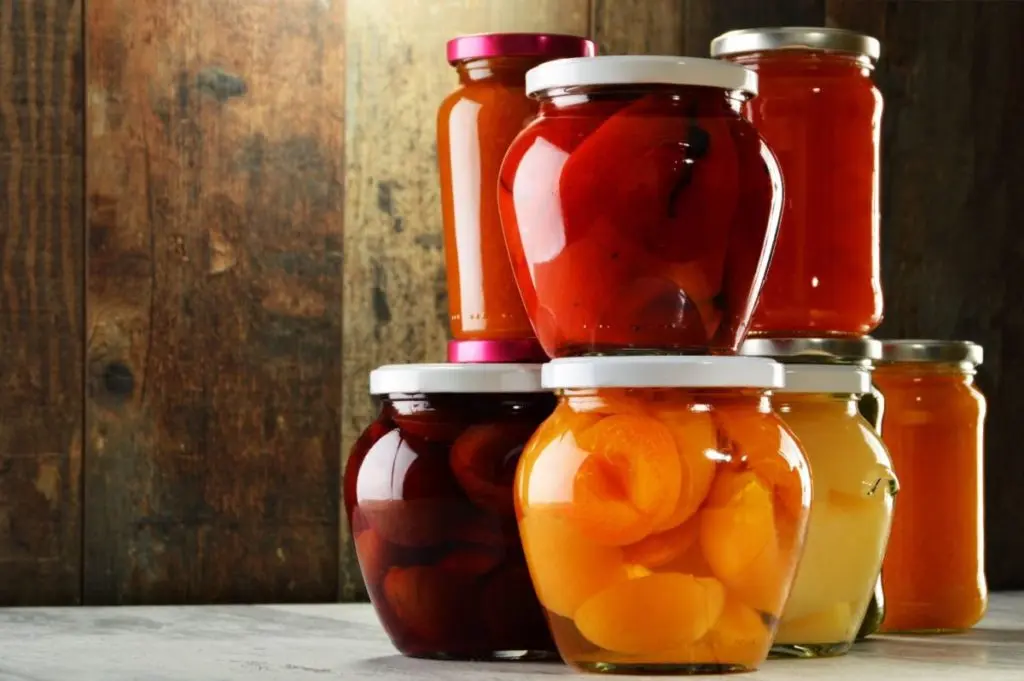
Preparing jam
Inexperienced housewives are interested in how to sterilize jars with blanks in the microwave. You can not disinfect jam jars separately, but put them in the chamber already filled. Conditions: jam should not reach the edges of 5 cm. There should be no lids.
Sequence:
- Jars of jam are arranged so that they do not touch each other. The power is set to maximum. The timer is set for six minutes. In powerful ovens, 2 minutes is enough.
- When the process is completed, the door does not open immediately. Wait 4-5 minutes – all this time the product is being pasteurized.
- Remove jars with dry tacks. Roll up the jam with sterilized lids.
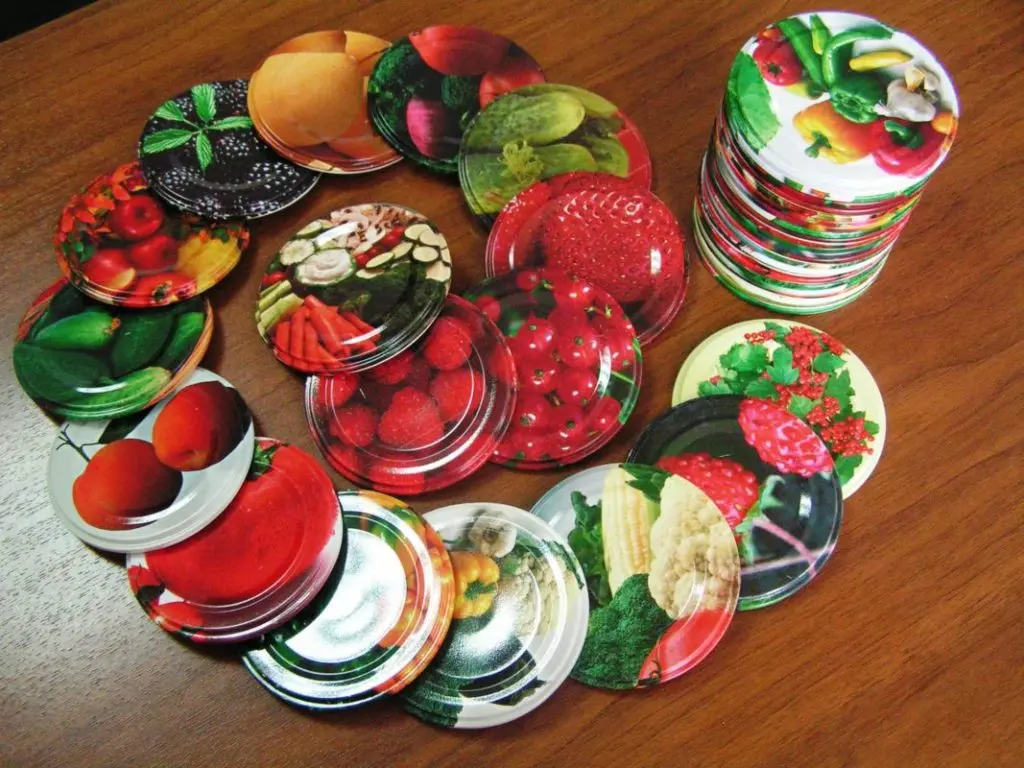
Harvesting pickles
Handling glass containers filled with pickles:
- Leave 2/3 of the volume. If the possessed boils, it will spill onto the tray and stain the chamber of the device. The empty space is filled later.
- Jars with blanks are placed on a pallet so that they do not touch. Process time – 3 min. Power at maximum. After turning off the stove, the door is not opened – they wait another 5 minutes.
- Having taken out the pickles with tacks, they leave them to cool slightly – while the tin lids are sterilized and dried. Now you can fill the jars to the top and cork.
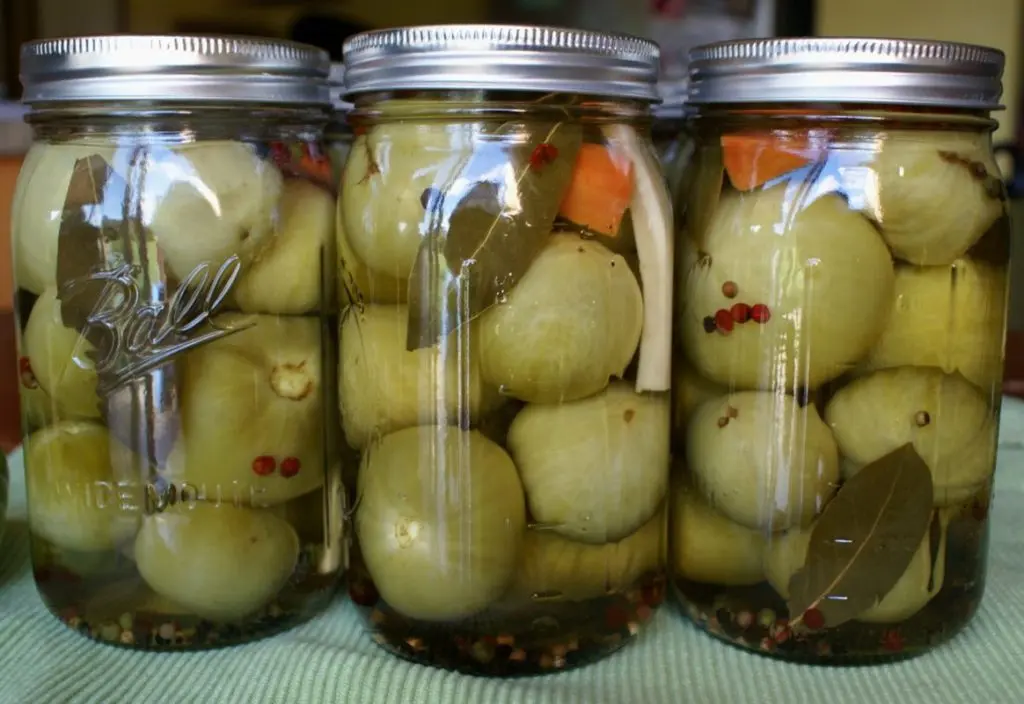
Harvesting fruits and berries
Housewives are interested in whether the microwave disinfects jars filled with raw berries and fruits. Yes, if done correctly:
- First, make syrup by mixing sugar and filtered water.
- Wash the berries. Bones do not need to be taken out. Remove rotten and rumpled berries, and fill a clean container with selected ones, stepping back from the edge of 5 cm.
- Pour in the prepared syrup. Put the jars in the chamber. Set the power to maximum. Pasteurization lasts 5 minutes, set this time on the timer. In powerful ovens, 2-3 minutes is enough.
If desired, you can pour the syrup after sterilization.
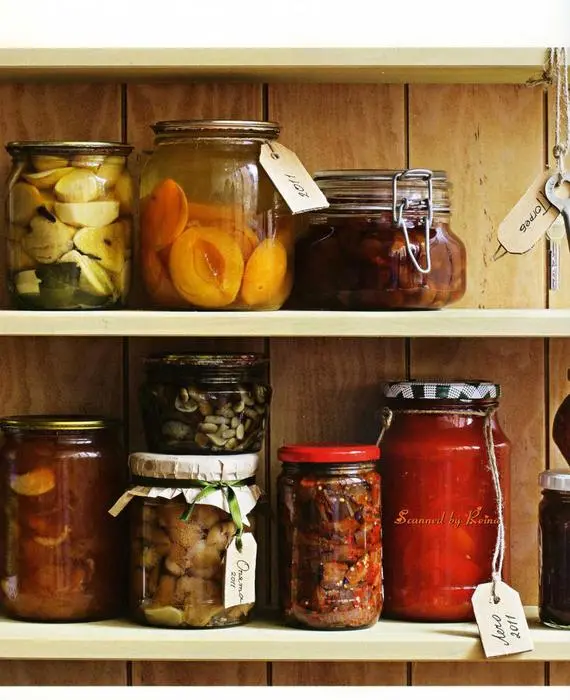
Bottle handling
Microwave is a versatile technique with a lot of useful properties. In addition to cooking, heating and defrosting, as it turned out, a microwave oven can sterilize bottles for baby food.
For disinfection, you can use several methods:
- boiling;
- antiseptic tablets;
- electrosterilizer;
- Microwave oven.
Using a microwave is a simple, reliable and safe way to disinfect glass containers. Disassembled bottles are placed in containers made of glass, special plastic or ceramics. Fill with water. Bottles must be uncapped. Processing time depends on the volume of water and the dimensions of the dishes – usually it is 5-10 minutes. The power is set, as in the case of conservation, to the maximum.
Read more on the topic on the page “How to sterilize baby bottles in the microwave.”
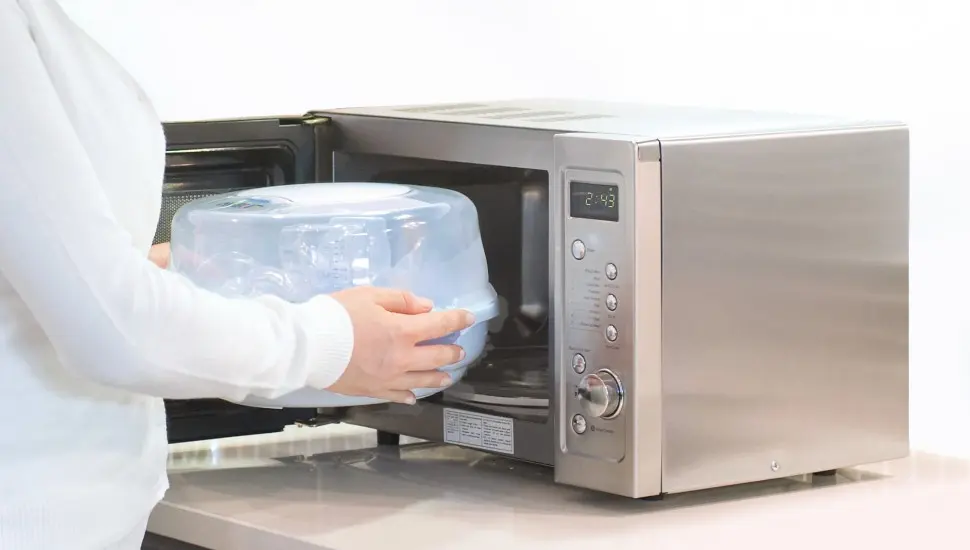
Reviews of hostesses who have already tried to sterilize containers for preservation using a microwave agree on one thing – it’s fast and convenient. The only thing they are unhappy with is that banks can burst during processing. To prevent this from happening, it is necessary to carefully inspect the dishes, setting aside specimens with defects.










